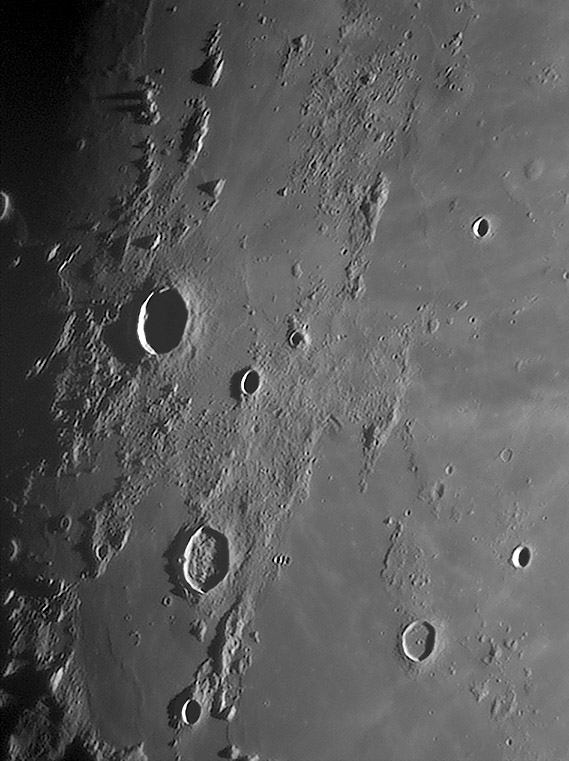
image by Bob Pilz
Do you recognize this area? Low lighting often makes a familiar scene look strange, which is good because it allows us to observe with a fresh perspective. Here is an area of relatively thin lavas that fail to completely cover rubbly basin ejecta. A number of shadow-casting linear ridges are aligned roughly north-south, suggesting that the basin ejecta surged from top to bottom (or vice-versa), removing all the crater rims and obstacles that were perpendicular to its devastating flow. The ejecta is from Imbrium, and the shadow-filled crater to the left is 32 km wide Kepler. The similar shaped crater below and right of Kepler is 29 km wide Encke, and to its lower right is Kunowsky (18 km). All three of these craters are relatvely shallow and have unusual rims. Encke is a good example, the inner and outer slopes are relatively simple, and as Harrison Schmidt called them (before he became an astronaut) they have delta (as in the Greek letter)-shaped rims. Thirty years ago, when I developed a morphological classification scheme for craters, I included these with the Gambart type. Gambart type craters occur in this region south of Imbrium and in very few other places on the Moon. It has been speculated that Gambart type craters could be volcanic calderas (unlikely) or basin secondaries (more likely). Can you find some more?
Technical Details:
Feb 28, 2007, ~03:43UT. 200mm f/6 Newtonian reflector + Televue 3x Barlow + DMK 21BF04 B/W camera + ‘Blue’ IR-block filter, .20 arcsec/pixel, 30 fps, 1/39 sec, 1400/7900 frames stacked; Processed in Registax, ImagesPlus, PS CS. Taken from Lat: 35 degrees 36 minutes N, Long: 82 degrees 33 minutes W, Elev:~850m.
Related Links:
Rükl chart 30
Bob’s website
Yesterday's LPOD: Ring Eclipse
Tomorrow's LPOD: An Unexpected Skyful of Stars
COMMENTS?
Register, Log in, and join in the comments.



